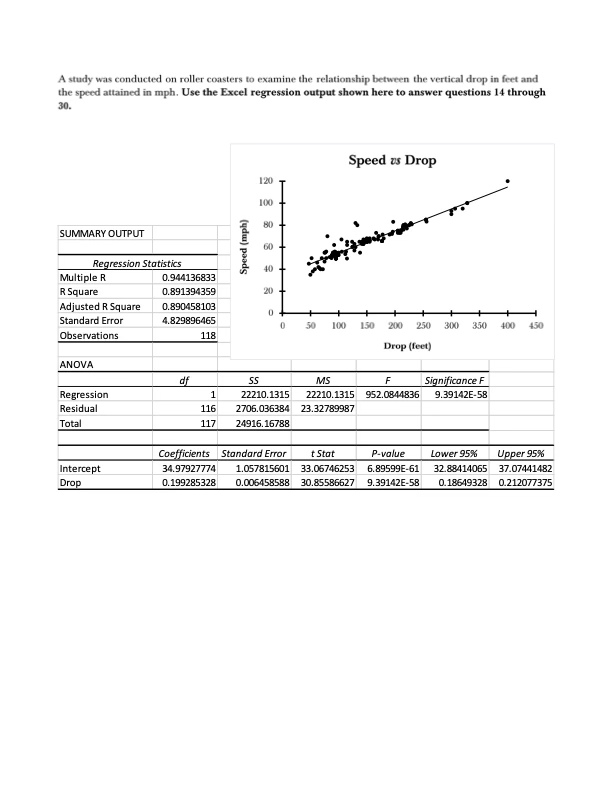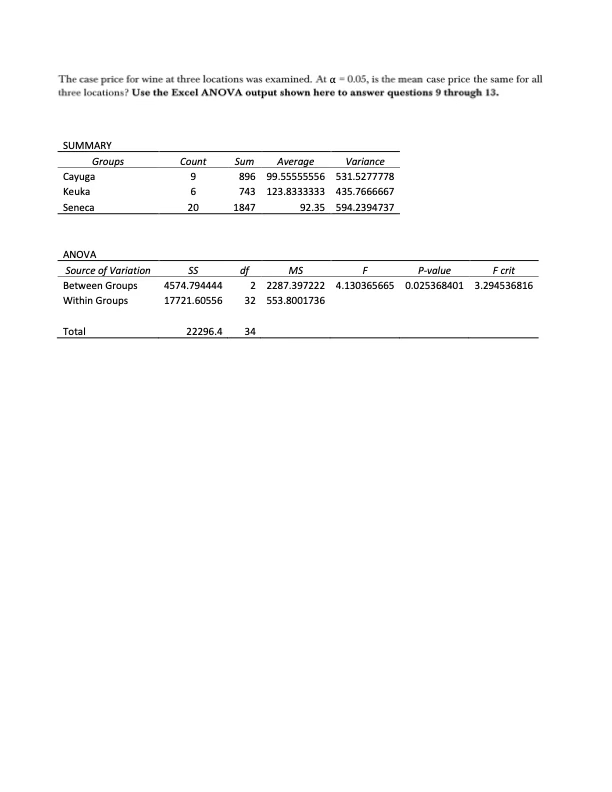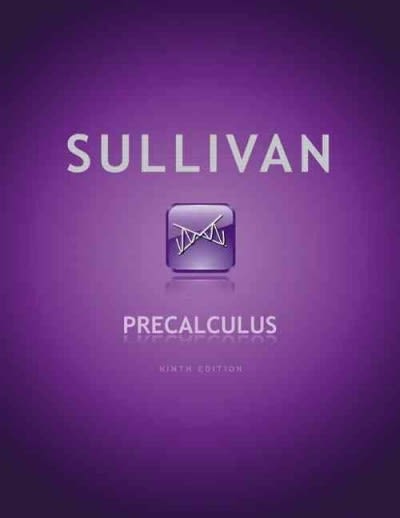Question
Math 10 Practice Exam 4 PLS SHOW WORK and ANSWER ALL THE QUESTIONS ---- NO EXCEPTION ) ( NOTE: your answer should be among the
Math 10 Practice Exam 4
PLS SHOW WORK and ANSWER ALL THE QUESTIONS ---- NO EXCEPTION) (NOTE: your answer should be among the multiple choice questions/ answer if it's it means your is wrong so pls do your correctly and carefully!!!!!) NO MADE UP ANSWERS PLS AND THANK YOU!!!!!)
For Questions 9 - 30, use the pdf file Practice Exam 4 - ANOVA and Regression Excel output locatedin the Discussions section.
Question 1
A researcher wonders whether an association exists between car color and the likelihood of being in an accident. Sample data were gathered and are shown below. Calculate the test statistic value for testing whether car color is independent of accident likelihood.
| ? | Red | Black | White |
| Car has been in an accident | 26 | 21 | 30 |
| Car has not been in an accident | 27 | 35 | 41 |
A.) 1.50
B.) 1.92
C.) 1.83
D.) 1.71
E.) 1.64
Question 2
A medical study examined the average effect of a new treatment regimen and obtained the following summary statistics.
| Treatment | Control |
| x1 = 101.4 | x2 = 99.7 |
| s1 = 1.4 | s2 = 1.3 |
| n1 = 8 | n2 = 6 |
Can it be concluded that the average effect for the treatment regimen is greater than for the control? Estimate the P-value for a test of this claim.
A.) 0.02 P-value
B.) 0.01 P-value
C.) 0.025 P-value
D.) 0.05 P-value
E.) 0.10 P-value
Question 3
According to the manufacturer of M&M candy, the color distribution for plain chocolate M&Ms is 13% brown, 13% red, 14% yellow, 24% blue, 20% orange, and 16% green. A 1.69-ounce bag of plain chocolate M&Ms was opened, and the counts for each of the colors noted. The results are shown below. Are the sample data consistent with the manufacturer's claim? Compute the test statistic value for a test of the claim.
| Color | Brown | Red | Yellow | Blue | Orange | Green |
| Observed | 10 | 4 | 5 | 15 | 12 | 10 |
A.) 3.301
B.) 3.724
C.) 3.882
D.) 3.675
E.) 3.533
Question 4
A farmer decided to use a new additive to grow his crops. He divided his farm into 10 plots and kept records of the corn yield (in bushels) before and after using the additive. The results are shown below. Do the data support the conclusion that the additive increases plot yield? Compute the test statistic value for a test of the claim.
| Before | 9 | 9 | 8 | 7 | 6 | 10 | 5 | 9 | 10 | 11 |
| After | 10 | 9 | 9 | 8 | 7 | 8 | 6 | 10 | 9 | 12 |
A.) -1.177
B.) -2.306
C.) -1.584
D.) -0.400
E.) -2.551
Question 5
In a study of mean body temperatures for men and women, the following table was obtained.
| Men | Women |
| x1= 98.105 | x2= 98.394 |
| = 0.489 | = 0.552 |
| n1= 65 | n2= 65 |
Construct a 90% confidence interval for?1-?2, the difference between the mean body temperature of men and the mean body temperature of women.
A.) -0.537?1-?2
B.) -0.440 ?1-?2
C.) -0.468 ?1-?2
D.) -0.616 ?1-?2
E.) -0.498 ?1-?2
Question 6
In a sample of 150 men, 132 said that they had less leisure time today than they had 10 years ago. In a random sample of250women, 234 women said that they hadless leisure time than they had 10 years ago. Compute the test statistic value for a test of whether the proportions are the same or not.
A.) -1.94
B.) -1.82
C.) -1.57
D.) -1.68
E.) -1.76
Question 7
According to Benford's Law, a variety of data sets include numbers with leading (first) digits that obey the following distribution: 30.1% are 1, 17.6% are 2, 12.5% are 3, 9.7% are 4, 7.9% are 5, 6.7% are 6, 5.8% are 7, 5.1% are 8, and 4.6% are 9. When working with the district attorney, a fraud investigator analyzed the leading digits of the amounts from 784 checks issued by a suspect company. The observed data are shown below. If the observed frequencies are substantially different from the frequencies expected from Benford's Law, the check amounts appear to result from fraud.
| Digit | 1 | 2 | 3 | 4 | 5 | 6 | 7 | 8 | 9 |
| Observed | 251 | 114 | 86 | 67 | 89 | 52 | 47 | 42 | 36 |
Suppose the test statistic value is ?2 = 19.655 for a chi-square goodness-of-fit test comparing the observed data with Benford's Law. Using ? = 0.01, is there sufficient evidence to conclude the checks are the result of fraud?
A.) H0 is not rejected. The checks are not the result of fraud.
B.) H0 is rejected. The checks are the result of fraud.
C.) H0 is rejected. The checks are not the result of fraud.
D.) H0 is not rejected. The checks are the result of fraud.
Question 8
A study was conducted on the percentages of on-time arrivals for major U.S. airlines. Two regional airlines were surveyed. For Airline A, 213 out of 300 flights were on-time. For Airline B, 185 out of 250 were on-time. Construct a 90% confidence interval for the difference between the proportions of flights that are on-time for Airline A and Airline B.
A.) -0.093 p1 - p2
B.) -0.128 p1 - p2
C.) -0.079 p1 - p2
D.) -0.119 p1 - p2
E.) -0.105 p1 - p2
Question 9
What is the ANOVA F test statistic value?
A.) 0.0254
B.) 4.130
C.) 3.295
D.) 32
E.) 34
Question 10
What is the critical value for the test?
A.) 34
B.) 32
C.) 0.0254
D.) 3.295
E.) 4.130
Question 11
What is the P-value for the test?
A.) 34
B.) 3.295
C.) 0.0254
D.) 4.130
E.) 32
Question 12
Is the null hypothesis rejected?
A.) No
B.) Yes
Question 14
Which phrase best describes the relationship between the two variables?
A.) positive linear relationship
B.) negative linear relationship
C.) no discernable relationship
D.) nonlinear (curvilinear) relationship
Question 15
What is the value of the coefficient of determination?
A.) 0.944
B.) 0.199
C.) 0.972
D.) 0.891
E.) 4.830
Question 16
What is the value of the sample correlation coefficient?
A.) 0.972
B.) 0.199
C.) 0.891
D.) 4.830
E.) 0.944
Question 17
What is the sample size?
A.) 118
B.) 116
C.) 120
D.) 119
E.) 117
Question 18
What is the explanatory variable?
A.) drop
B.) speed
Question 19
What is the response variable?
A.) speed
B.) drop
Question 20
What is the test statistic value for the hypothesis test concerning the existence of a linear relationship between the two variables?
A.) 34.979
B.) 0.199
C.) 33.067
D.) 4.830
E.) 30.856
Question 21
What is the P-value for the hypothesis test concerning the existence of a linear relationship between the two variables?
A.) 0.05 P-value
B.) 0.01 P-value
C.) P-value
D.) P-value > 0.10
Question 22
What is the conclusion for the hypothesis test concerning the existence of a linear relationship between the two variables?
A.) A nonlinear (curvilinear) relationship exits.
B.) Cannot be determined.
C.) A linear relationship exists.
D.) No linear relationship exists.
Question 23
What percentage of the variation in the observed speeds is explained by a linear relationship between drop and speed?
A.) 89.1%
B.) 4.83%
C.) 97.2%
D.) 95.0%
E.) 94.4%
Question 24
What is the linear regression equation?
A.) y' = 34.979 + 1.058x
B.) y' = 34.979 + 0.199x
C.) y' = 0.199 + 0.006x
D.) y' = 0.199 + 34.979x
Question 25
What is the estimated standard deviation for the residuals (i.e., sest ) ?
A.) 34.979
B.) 4.830
C.) 1.058
D.) 0.006
E.) 0.199
Question 26
What speed does the linear regression model predict for a drop of 144 feet?
A.) 61.7 mph
B.) 65.1 mph
C.) 71.3 mph
D.) 63.6 mph
E.) 69.8 mph
Question 27
What is the residual that corresponds to the observed data point (144, 67)?
A.) -3.4
B.) 2.8
C.) -2.8
D.) 3.4
E.) 1.9
Question 28
What is the 95% confidence interval for the slope of the regression line?
A.) (32.884, 37.074)
B.) (30.856, 33.067)
C.) (0.186, 0.212)
D.) (0.006, 1.058)
Question 29
What is the meaning of the slope estimate b = 0.199 as it relates drop to speed?
A.) For every increase of 199 feet in drop, speed increases by 100 mph.
B.) For every increase of 19.9 feet in drop, speed increases by 1 mph.
C.) For every increase of 100 feet in drop, speed increases by 1.99 mph.
D.) For every increase of 10 feet in drop, speed increases by 19.9 mph.
E.) For every increase of 100 feet in drop, speed increases by 19.9 mph.
Question 30
What does the linear regression model predict would be the change in speed given an increase in drop of 80 feet?
A.) about 48 mph faster
B.) about 8 mph faster
C.) about 16 mph faster
D.) about 32 mph faster
E.) about 64 mph faster


Step by Step Solution
There are 3 Steps involved in it
Step: 1

Get Instant Access to Expert-Tailored Solutions
See step-by-step solutions with expert insights and AI powered tools for academic success
Step: 2

Step: 3

Ace Your Homework with AI
Get the answers you need in no time with our AI-driven, step-by-step assistance
Get Started


